Stages of developing a mobile application for a bank
Development stages mobile application for the bank
Today it's hard to imagine everyday life without a banking app. We transfer money to friends, pay for services, monitor spending — and we do all this from a smartphone in a couple of clicks. You don't even have to go anywhere to issue a card anyone — a virtual card is issued in 5 minutes right in the app.
Today, 91% of customers choose a bank based on the convenience of mobile banking — the app has largely become a full-fled replacement for a branch. Under these conditions, developing a bank application requires an understanding of what services and functions real users of banking applications need and how to implement them.
In Russia, for example, mobile banks are already among the most popular digital services: in 2023, they ranked second in popularity among all categories of mobile applications. And about 3.6 billion people around the world use online banking, and the numbers continue to grow.
This shift means one thing: for a bank, having a convenient and secure mobile application is not a competitive advantage, but a necessary minimum. More, a well-designed application helps not only retain current customers, but also attract new ones.
What is behind the development of a banking application? What stages does it go from idea to release? And how do you create a service that users can trust with their money: with a user-friendly interface, stable operation and reliable protection? Let's figure it out one by one.
Why banks are moving to smartphones: the mobile banking market in 2025
Why banks are moving to smartphones: the mobile banking market in 2025
Users are switching to digital channels en masse, and the mobile application has become their main way of obtaining banking services. Traditional branches are fading into the background: in the CIS, 89% of customers already use banking services via smartphones, while in Europe this figure is growing rapidly. Those who do not have time to adapt services to the mobile format lose customers: it is estimated that up to 76% of users are willing to change banks for a more convenient application. In other words, without mobile development, it is difficult for a bank to retain customers and stay on the market.
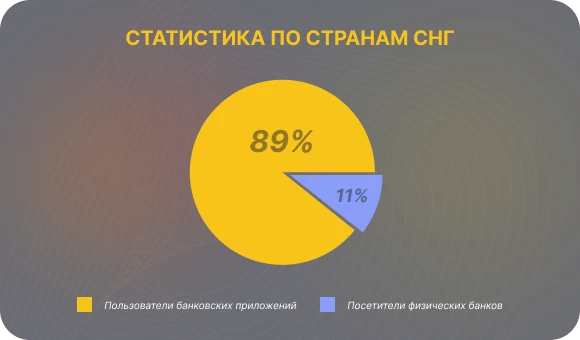
The market is becoming more competitive, and the struggle is not only between traditional banks: fintech companies that have focused on mobile technologies from the very beginning are coming to the forefront.
Different customers, different scenarios
A mobile banking application should take into account the needs of several audiences at once. Here are three main groups:
- Private users: from students to retirees
For most people, a smartphone is the main financial instrument. The app checks the balance, transfers money, pays bills, manages cards, and uses all key bank services. More, the younger the customer, the higher the expectations for speed and convenience: up to 68% of millennials call the mobile app their main channel of work with the bank.
- Business customers: speed, control, automation
It is important for small and medium-sized businesses to control expenses, pay bills, send salaries, and integrate with accounting. More and more banks are creating separate business applications and platforms that are adapted to the needs of companies.
- Bank employees: internal tools are also important
Mobile interfaces are also created for internal use, for example, to consult clients outside the office, approve applications, or work with analytics. These decisions are invisible to an external audience, but they directly affect the bank's efficiency and the quality of services. Their development requires as much attention as client interfaces.
That is why developing banking applications is becoming a priority for companies that want to retain customers and meet the expectations of the digital generation.
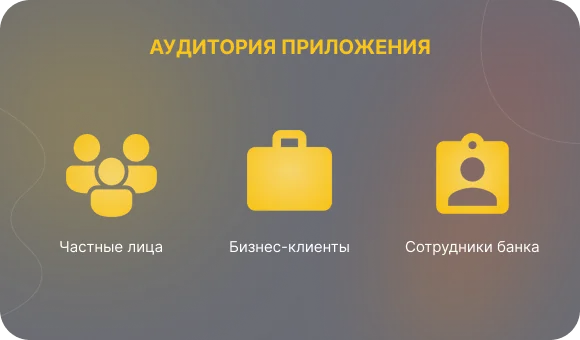
Who is already doing well: competitors' practices
There are already strong players on the market, and their experience is worth exploring:
- T‑Bank (Tinkoff). He was the first in Russia to build a bank without branches. More than 34 million users, a powerful platform that combines financial services and services, cashback, investments and AI assistant.
- Sberbank Online. An impressive audience of over 85 million monthly active users. The app has become the center of the ecosystem: from transfers to the marketplace, and the built-in AI assistant helps solve user requests without calls and queues.
- Revolut. A European neobank with a focus on multicurrency, security and personal financial services. Easy account opening, instant transfers, and flexible settings, all within one mobile platform. As a result, by 2025, the app had more than 60 million users.
- Monzo. A British bank with a focus on transparency and a friendly interface. The app includes budgeting, shared billing, and live chat with support. More than a third of customers use it as their main bank.
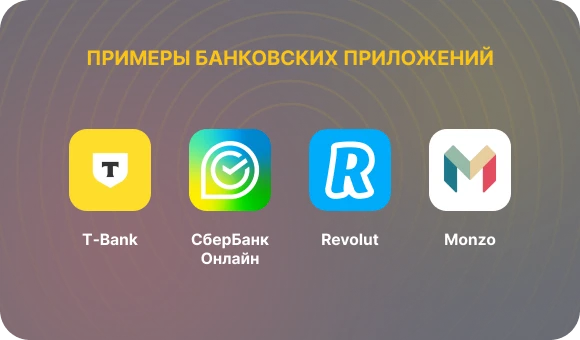
What's important for banking app users
What's important for banking app users
Regarding the country, customer expectations are similar. Here are three key needs to consider when developing:
- Simplicity and affordability. The app should work fast and show only the services and functions you need. A couple of clicks and the money has already been transferred: this has long been the standard of banking technology.
- Safety without unnecessary steps. It is important for users to be sure that their data and money are protected. But at the same time, don't spend half a minute on each entrance. The best solutions already include biometrics, push notifications, instant card blocking, and AI-based anti-fraud.
- Personal approach. Users are waiting for recommendations and tips from banking platforms. Offer a deposit when the amount has accumulated, remind you to pay utility bills, and show spending analytics. Such little things build trust and loyalty.
What a banking app should be able to do
What a banking app should be able to do
A modern banking app is not just a money transfer service. This is a complete financial management tool, with well-thought-out logic and clear navigation. And the better it responds to requests from different groups of users, the higher the bank's credibility.
For private customers: everything is at hand
It is important that the basic scenarios — everything that customers use on the platform every day — work quickly, do not require extra steps, and are logical and understandable.
- Register and log in. The simpler the better. At the same time, it is important to provide protection: support for Face ID, fingerprint, SMS code, and other two-factor authentication methods.
- Accounts and cards. The user should see the balance, statements and transaction details for all connected cards without unnecessary transitions and confusing menus.
- Payments and transfers. A transfer to a friend, a rent bill or a utility bill — everything should be done in a few simple steps.
- Loans and deposits. The user can apply, view the schedule, replace the deposit or close the loan ahead of schedule.
- Investments. Access to stocks, bonds, funds, basic analytics. The easier it is to sign in, the higher the engagement.
- Financial assistant. Cost accounting tools, budget planning, money management tips.
- Push notifications. Prompt notifications about logins, transactions, receipts and personal offers.
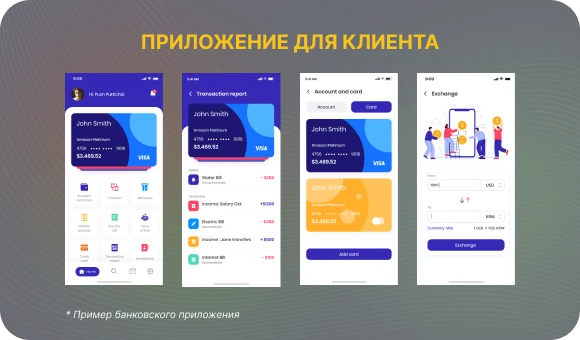
For business: control and automation
Entrepreneurs have their own tasks. They need an app where they can manage the flow of money not only quickly but also transparently, often together with a team.
- Corporate accounts. The user can quickly check corporate account balances, filter the company's operations, and upload statements.
- Integration with accounting. The application connects to accounting systems like 1C or QuickBooks to synchronize data and simplify accounting.
- Batch payments. Salaries, taxes, and other recurring payments to the company can be sent in batches. This saves time and reduces the risk of errors.
For bank employees: analytics and management
If the application is used within the bank, it should be no less convenient and secure.
- Monitoring actions. Employees can monitor real-time statistics and see what actions users are taking.
- Access management. The control panel allows you to easily configure profiles, access rights, and settings for different roles.
- Analytics. Built-in analytics show how app features are used, where the load occurs, and how actively users are involved.

Thus, the development of a bank's mobile application requires taking into account different use cases — from private customers to employees and entrepreneurs.
How a banking app is created: step by step
How a banking app is created: step by step
Creating a banking application is not just a technical task. There is a lot of work behind creating a simple and understandable service, from studying requirements to testing and support. To make the application stable and user-friendly, the team goes through several key steps.
Step 1 — Research and Prototyping
Before you start creating a bank app, you need to understand exactly why it is being created and what exactly is important to users. The team collects requirements from the bank and determines the goals of the project: taking into account the specifications of banking activities, technical details, legal restrictions, and business goals. At the same time, they interview customers and study how they use banking services to help determine what features are really needed.
Based on this data, user stories are generated — simple descriptions of each action available to the user in the application. Then prototypes are developed — draft screen layouts that help you imagine how the application will work. All this is needed to make sure that the platform will solve the problems of real people and meet the bank's requirements. Already at this stage, the basis for the further development of the entire project is being formed.
Step 2 — Design
Once the application structure is defined, the team starts working out the interface and interaction logic. All functions should be arranged logically, actions should be performed without unnecessary steps, and user data should remain protected. The design adapts to different types of devices and takes into account accessibility requirements.
The design task is not only to make the application visually pleasing, but also to think about how it will be convenient for the user to use it. It is important to understand in advance what steps he is taking, at what point he may get confused, and how to help him get through the path without delay or irritation. All these details are taken into account even before full development begins.
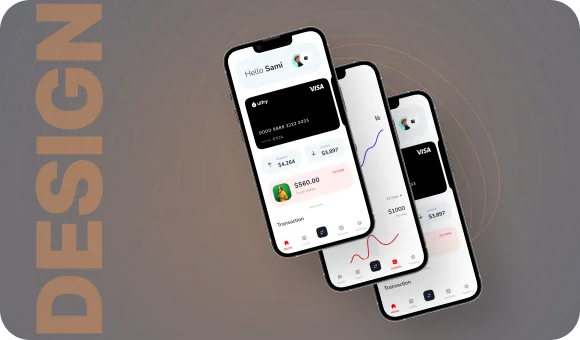
Step 3 — Development
When the design is approved, technical implementation begins. Developers write code and launch basic functions: transfers, account management, data protection. At the same time, the bank's internal systems and external services are connected, for example, those that help verify documents or calculate a loan.
Working on a project is a well-coordinated process involving a multidisciplinary team. Front-end developers are responsible for creating an intuitive and convenient user interface. At the same time, backend specialists build all internal logic and manage data. DevOps engineers ensure the stability and speed of the entire infrastructure, and the QA team (testers) ensures that every element of the system functions flawlessly. Only close coordination of all these areas allows us to create a single and reliable product.
Step 4 — Testing
Before launching the application, you need to check it carefully. Specialists are testing the application's functions: whether registration works, whether transfers are being made, whether the balance for each card is displayed correctly. Special attention is paid to security — it is important to make sure that user data is protected and attackers cannot hack the system.
In addition, a strength test is being carried out. The app is loaded as if thousands of people are using it at once, simulating a typical banking load, to see how it behaviors. If there are crashes or delays somewhere, the development team fixes the issues. All this is necessary so that the application is already stable and reliable by the time it is launched.
Step 5 — Launch and Support
When the app is ready and has passed all the testing stages, it is published on the App Store and Google Play. But the work doesn't end there — the next important phase begins. The team monitors how the app works in practice: it collects feedback, tracks crashes and errors, and watches how users behave within the service.
Based on this information, updates are being released. Some things are being improved, some are being simplified, and new features and services are emerging that customers expect first of all. A good app doesn't stay the same — it grows with audience expectations and the changing market.
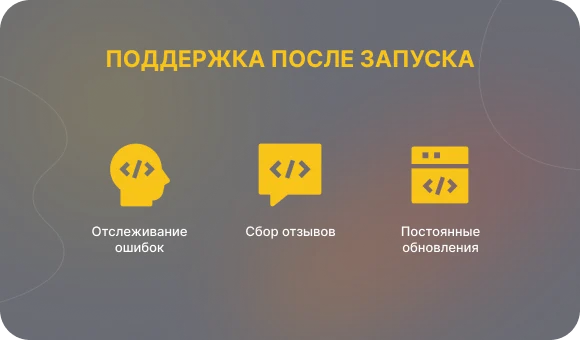
Data protection as a priority
Data protection as a priority
Reliability and security are at the core of a banking application. The user must be sure that their data will not fall into the wrong hands, and access to the account and money is securely protected. And here, not only data protection is important, but also technology for early risk detection: anti-fraud systems, encryption, biometrics.
From the very beginning, the mobile banking project includes all the necessary measures: encryption (for example, AES-256), secure transmission channels, and two-factor authentication. The application must be tested for compliance with standards such as GDPR, PCI DSS and the requirements of the Central Bank.
In addition to technical measures, monitoring systems are being introduced that help identify suspicious actions in time and prevent fraud attempts. Periodic safety audits confirm that the product is stable and ready for use.
The legal framework is under control
The legal framework is under control
A bank application cannot be released without complying with all formal requirements. This is especially important for banking products that work with financial transactions and customer data. At the preparation stage, Central Bank regulations, local laws and international regulations are taken into account.
At the same time, user agreements and privacy policies are being prepared. It is also important to work out the issue of licenses in advance, which is important for a product that works with payment systems. This builds trust and minimizes risks for the bank.
How to choose a team to develop a bank mobile application
To create a strong banking application, you need a development team that understands how fintech works and can work with security, convenience, and speed. It is important to consider everything — from the interface to integration with bank systems and support for key functions and services within the application.
A properly implemented banking application can be a breakdown in the industry: take your product to a new level, increase customer loyalty, and even set a market trend.
The Beetrail team takes care of the entire process, from idea to launch. We specialize in developing mobile applications for banks and financial companies, and we support the project at every stage: from analytics and design to development, testing, release and subsequent development of the project.
We use proven technologies and select solutions for the tasks and scale of the product, and we know how to make a product that will be trusted.
Would you like to discuss your project? Write to us — together we will determine the stages, tasks and format of development, and select a solution for your goals and budget.










